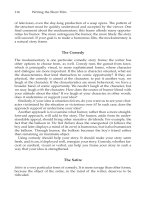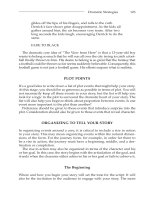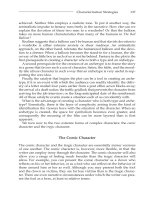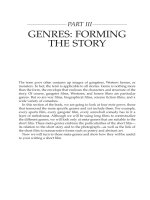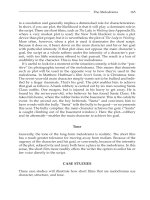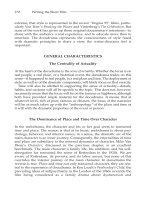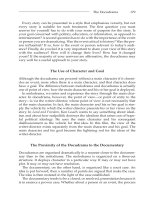Tài liệu Writing the short film 3th - Part 28 pdf
Bạn đang xem bản rút gọn của tài liệu. Xem và tải ngay bản đầy đủ của tài liệu tại đây (129.51 KB, 7 trang )
Every story can be presented in a style that emphasizes veracity, but not
every story is suitable for such treatment. The first question you must
answer for yourself has to do with your sense of purpose for the story. Is
your goal concerned with politics, education, or information, as opposed to
entertainment? A second question has to do with the importance of the event
or person you are dramatizing. Was the event critical to history? Was the per-
son influential? If so, how is the event or person relevant to today’s audi-
ence? Finally, do you feel it is very important to share your view of this story
with the audience? How will it change their lives? How has it changed
yours? If the majority of your answers are affirmative, the docudrama may
very well be a useful approach to your story.
The Use of Character and Goal
Although the docudrama can proceed without a main character if it chroni-
cles an event, more often there is a main character, and that character does
have a goal. The difference between melodrama and docudrama is actually
one of point of view: how the main character and his or her goal is deployed.
In melodrama, we enter and experience the story through the main char-
acter. In docudrama, however, the point of view—or point of entry to the
story—is via the writer-director, whose point of view is not necessarily that
of the main character. In fact, the main character and his or her goal is sim-
ply the vehicle by which the writer-director presents his or her views on the
story. In Land and Freedom, Ken Loach wants to say something about ideal-
ism and about how realpolitik destroys the idealism that arises out of hope-
ful political ideology. He uses the main character and his consequent
disillusionment as the vehicle for that idea. In this film, the view of the
writer-director exists separately from the main character and his goal. The
main character and his goal become the lightning rod for the ideas of the
writer-director.
The Proximity of the Docudrama to the Documentary
Docudramas are organized dramatically in a manner closer to the documen-
tary than to the melodrama. The melodrama is organized on a three-act
structure. It deploys character in a particular way. It may or may not have
plot. It may or may not have resolution.
The documentary, on the other hand, is organized like a court case. An
idea is put forward, then a number of points are argued that make the case.
The idea is then restated in the light of the case established.
The documentary tends to be a closed, or resolved, presentation because it
is in essence a proven case. Whether about a person or an event, the process
The Docudrama 179
Ch14.qxd 9/27/04 6:10 PM Page 179
will be the same. The case will be made. The docudrama makes a case for the
writer-director’s views upon a person or event. The writer-director organ-
izes the story around the case structure. If the film concerns a person, the
character and his goal constitute the vehicle for the case—so too does the
course of an event, if the story focuses on one. The shape of the docudrama
follows the shape of the documentary rather than that of the melodrama.
Plot Is Used in the Same Manner as the Main Character and His
or Her Goal
Plot in the melodrama is used in opposition to the main character and his or
her goal. Since the role (that is, view) of the writer-director is the dominant
presence in the docudrama, a parallel process goes on in the deployment of
plot. Plot serves to illustrate, and make the case for, the views of the writer-
director. In Culloden, Peter Watkins has particular views on the imperialism
of England vis-à-vis Scotland, and Scotland’s 18th-century venture into
nationalism. The plot, the Battle of Culloden, is Watkins’s case against
England, and he finds the country guilty.
Find the Structure That Is Suitable to the Story
Several of the previously mentioned docudramas use narrators. It is by no
means mandatory that there be a narrator; however, the device, borrowed
from documentary, is commonly used in docudrama. Very often that narra-
tor assumes the journalistic role of reporter, and so the structure proceeds as
a piece of reportage (Culloden). Another approach to the narrator is to use a
diarist. In Loach’s Land and Freedom, the letters of the main character docu-
ment the story.
Whether reporter or diarist, the framing device of a shared piece of
reportage or a recorded piece of personal history provides an entry point
into what is essentially historical material. The presence of the narrator helps
shape for the audience what might otherwise be difficult or inaccessible
material. The narrator is a useful device to structure the story.
This differs from the playwright’s approach to a real life event, such as the
Battle of Gallipoli. David Williamson’s treatment of events in the Peter Weir
film Gallipoli is very dramatic, and we do enter the story through the experi-
ence of two main characters. The treatment, however, is very different from
the narrator approach earlier described for the docudrama.
The second dimension to the structure of the docudrama is that it can be
shaped as a character-driven or a plot-driven narrative. Whichever is cho-
180 Writing the Short Film
Ch14.qxd 9/27/04 6:10 PM Page 180
sen, the narrative tends to have closure or resolution. In this sense, it differs
from melodrama, which can proceed either to an open-ended conclusion or
to resolution.
THE SHORT FILM
Having elaborated upon the features of the docudrama in the long film,
what is the balance between subject matter and style in the short film? Are
main character and goal, plot, and tone deployed in a manner that supports
the authorial voice? How much if any variance in tone does the short docu-
drama tolerate? These are questions to which we now turn.
Style in the Short Film
In the short film, the notion that you are watching a documentary is even
more critical than in the long film. Consequently, the deployment of jour-
nalistic techniques, from camera style to on or off-air narration, is critical. In
fact, the first narrative responsibility of the writer is to create at least the illu-
sion that what we are watching are real people at real work or leisure. A can-
did quality, even the sense of “eavesdropping,” should inform the writing
and the style of performance. This “spontaneity” immediately establishes
veracity and seriousness, upon which the writer-director will draw. What is
being captured is not so much an enactment as the real thing. This is the cen-
tral style of the docudrama. It is the primary and foremost key to the success
of the docudrama.
The Main Character and the Goal
As in the long film, the main character, with his or her goal, is the vehi-
cle for the ideas of the writer-director. Although the character may be
vivid or important, the narrative has to create a large place for the voice
of the writer-director. We will look at this issue in detail below, under
structure.
The Role of Plot
As with the main character, plot too can be vivid; indeed, it can be the prin-
cipal focus of the narrative. However, the voice of the writer-director has to
be a counterweight. The plot, like the main character, has to be secondary to
the voice of the writer-director in this genre.
The Docudrama 181
Ch14.qxd 9/27/04 6:10 PM Page 181
Structure
Whether the narrative is plot-driven or character-driven, the dominant or
shaping element of the docudrama is the voice of the writer-director.
Whatever opinion is being pursued, it is that view that will shape the narra-
tive. Very much like a documentary, the narrative is shaped as a case to be
proven. Plot and character are tools used to illustrate, but the organization
and presentation of the narrative, whether through onscreen or offscreen
narration, is the principal shaping device. It is here where the voice of the
author resides.
Tone
The tone will be emphatically realistic, with as much detail to emphasize
realism as possible. This may mean camera style, or it may mean an on-air
narrator speaking directly to the audience. The one exception is the mocku-
mentary, where the realism itself is undermined as the viewer gradually real-
izes that it is realism itself that is being attacked.
Case Study in Character
Matt Mailer’s The Money Shot chronicles a particular film project. The film-
maker is the central character. He is following two “street kids,” both
teenagers in trouble. The film opens with the male subject confessing to
killing people. He is charming but brutal and very candid about what he
does. The female subject also lives a marginalized life—alienated from her
mother, she supports herself by prostitution, and she is a drug user. The film-
maker also interviews the young woman’s mother and the young man’s
aunt. Both duck the realities of the two young people’s lives. Both refuse to
speak about matters too personal to them. In the course of the narrative, the
filmmaker crosses the line and gets personally involved with both young
people. The young woman overdoses on drugs, and the young man kills a
policeman while being filmed. The filmmaker is thrilled to get the incident
on film, but when threatened by the young man, who wants the incriminat-
ing footage, the filmmaker tries to call his bluff. The young man kills him
and takes the film.
The character of the filmmaker is presented first as relentlessly pursuing
the truth about life on the streets. Later we see he is a user, interested only in
exploiting the situation, the entrapped and dangerous lives of two young
people. His cynicism about people and his zeal for exploitation in the end
cost him his life.
Matt Mailer is very interested, as others have been (Oliver Stone, in
Natural Born Killers), in the exploitative power of film. His voice implies
182 Writing the Short Film
Ch14.qxd 9/27/04 6:10 PM Page 182
that the media are two-edged swords. Their power can destroy the lives of
the subjects as well as of the observers. This cautionary tale uses the main
character and his goal to voice concerns about the media. A more satiric
form of this caution was the subject of Paddy Chayevsky’s Network. The
main character and his goal in The Money Shot is the primary vehicle for the
exploration of Mailer’s ideas about exploitation, media, and the power of
the media.
Case Study in Place
Helen Besfamilny’s Brighton Blues is a story about the Russian émigré com-
munity in the Brighton Beach area of Brooklyn. The story is a simple one. A
Russian wanders into a deli and admires the variety of food. The woman
behind the counter is young, an American. He tells her he cannot afford the
food, that he spent his money on cigarettes. She invites him out for dinner.
Their night together is a bittersweet one. Other émigrés drop in to her apart-
ment while he sleeps off the evening. He leaves but returns to invite her to
accompany him to the airport, from which he’ll leave for home, the USSR.
She refuses, but after he leaves she follows, loaded down with food for him.
She goes to the subway station, but they do not see each other. She is alone,
and he is gone. This brief description does not capture the despair, loneli-
ness, and the fleeting joy these people experience in the film.
The film uses a blue filter to present an attitude about Brighton Beach.
The cinema verité footage of the deli, the restaurant, the street, and the
subway station, as well as the beach, echo a community in a deep malaise.
The émigrés are not home in their new home. But they recreate the sounds
and smells and sights that remind them of home—Moscow, Mother Russia.
The film has a powerful sense of place and of nostalgia for that other home,
far away.
Besfamilny’s views about place infuse Brighton Blues and share with us a
profound sadness about displacement. This is her voice in Brighton Blues.
Cast Study in Plot
Ethan Spigland’s Strange Case of Balthazar Hyppolite tells the story of a film
archivist who finds some rare film footage by the filmmaker Balthazar
Hyppolite. The film predates the numerous technological discoveries that
helped create the film industry. Consequently, it is footage of considerable
historical importance. The balance of the film is devoted to searching and
reconstructing the footage. In the second part of the film, the main charac-
ter’s love interest in a fellow archivist is introduced. By the end, the
The Docudrama 183
Ch14.qxd 9/27/04 6:10 PM Page 183
